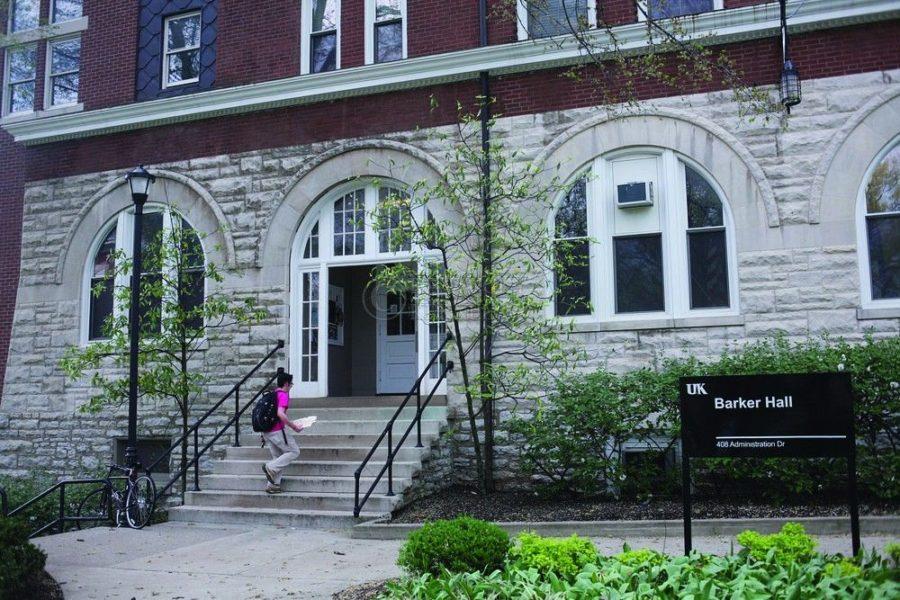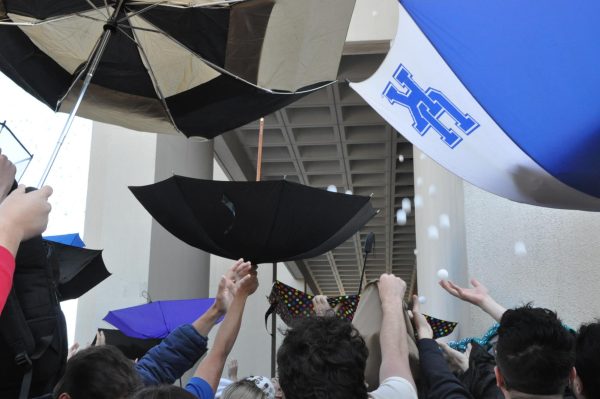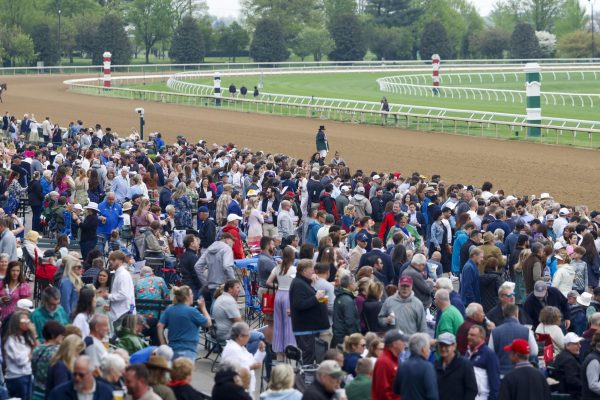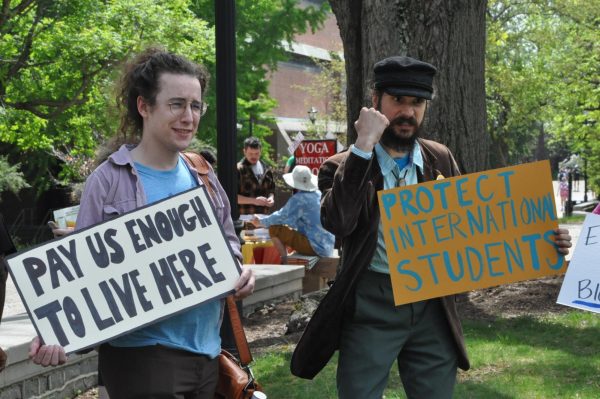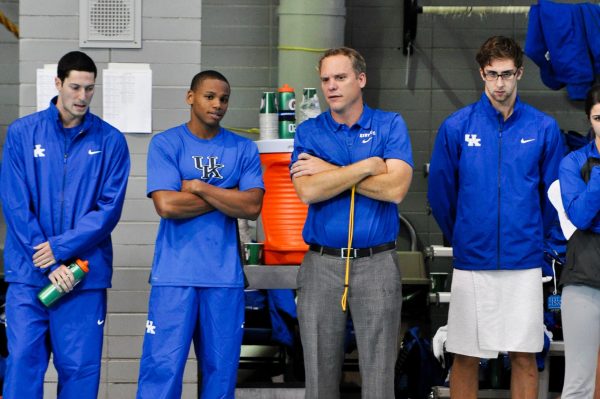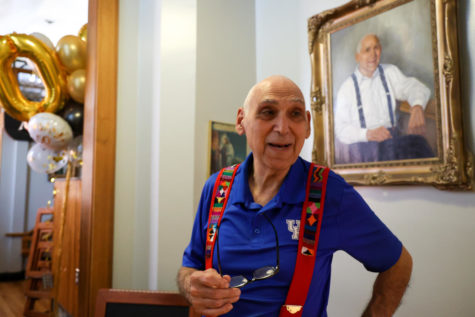Without new facilities, some people with disabilities unable to reach all of campus
April 25, 2012
By Rachel Aretakis
For some students with physical disabilities, more time is required to plan routes to class and ways to get into buildings.
“I purposefully go to the same buildings over and over again to make sure they are accessible,” said Nicole Hobbs, an English senior who has cerebral palsy.
Hobbs said she hates asking a random stranger to hold her crutches while she walks up the steps.
“I don’t want to ask them for help,” Hobbs said. “I don’t want to feel like a burden to them.”
She uses crutches to maneuver around campus and is independent, but sometimes when the elevators are down, she has to ask for help.
“If I can avoid asking people, like if I really don’t need to get to class immediately, I will wait for somebody from the disability office.”
With roughly 28,000 students at UK, in fall 2010 there were 1,200 registered disabled students, said Jake Karnes, director of the Disability Resource Center.
The center’s goal is to provide equal access to eligible students so that everyone has an equal opportunity to participate in what the university offers.
“Our office is actively looking at what needs to be done,” he said.
Hobbs has only had classes in two buildings: White Hall Classroom Building and Kastle Hall. She said she schedules her classes there because she knows for sure that they are accessible.
“I have to be conscious about location, too,” Hobbs said. “I can’t walk long distances.”
Even if the building is accessible, she has to keep an eye on how far she has to walk to get there.
Getting around on campus can be difficult, but she thinks the disability center does the best it can.
“I really think they care,” she said. But it can be frustrating when elevators aren’t working or certain doors are heavy, she said.
***
Money is always an issue, and addressing accessibility for physically disabled people in the UK community is no exception.
“We have more projects than we have funding,” said Bob Wiseman, the vice president of facilities. “Considerably more projects.”
During President Eli Capilouto’s investiture speech in October, he pledged to improve campus accessibility.
“The vast majority of our space is not accessible to people with disabilities — more so than any university in this state,” he said in his speech.
Disabilities range from physical to mental, and the Disability Resource Center advocates for accommodations and acceptance.
“We are a resource for them,” Karnes said. “We can help.”
Patty Bender, the assistant vice president for institutional equity and equal opportunity, said the office makes individual accommodations for employees.
“We have faculty that we rearrange their class schedule or rearrange what time of days they teach or where they teach,” she said. “It’s very individualized.”
From July 2010 to now, there have been 42 accommodation requests, she said. Last year there were 28.
“When we get requests, overall I think we do a pretty good job (of addressing them),” Bender said. She said she does get frustrated, though, when each year the budget is cut.
“How can we best use the money we get?” she asked.
***
Bruce Burris is the co-owner of Latitude Artist Community, a Lexington organization that provides an inclusive community, “with an emphasis on those thought by some to have a disability,” according to its website. The organization allows participating artists to contribute to the community.
“I think it’s outrageous that a university campus can still be as inaccessible as UK,” Burris said.
He used to lead a walking tour of downtown Lexington, where he would point out places a person in a wheelchair couldn’t access or that would be dangerous.
“I do think things are changing,” he said. “It’s still disappointing to know that after 30 years of looking at this problem, it is still as significant as it is.”
***
UK is one of the oldest campuses in the state.
“Being the oldest, we have buildings that have more challenges than most campuses,” Wiseman said.
He thinks the university has done a good job of making campus as accessible as possible, and he has made it a priority to keep campus repaired and increase the budgets for those elements.
However, Wiseman is working with limited funds, and renovating old buildings is expensive.
“I think the first principle … is that we need to make programs and classes as accessible as possible. That doesn’t necessarily mean the building,” he said.
Karnes said changes to campus infrastructure are gradual. The most dramatic change was in 1977 when Section 504 of the Rehabilitation Act of 1973 was implemented. This gave federal money to the university to make programs accessible.
As the university builds new facilities, officials make sure they are compliant with the law, Karnes said.
The Americans with Disabilities Act and Section 504 state that students with disabilities are “entitled to benefit from all the services of those institutions and to use campus facilities,” according to the ADA website.
Every building doesn’t have to be accessible; as long as programs can be moved, UK is in compliance with the law, Karnes said.
Karnes works with students with disabilities to accommodate their needs. He can help move classes if students can’t access them.
The building that makes up Barker Hall and Buell Armory, for example, does not have an elevator. If a student can’t access a class there, Karnes said the class will be moved to a different building.
A complaint has to be issued before the class can be relocated.
Five buildings on campus are in no way accessible to everyone, Wiseman said. They are the Mathews Building, Barker Hall and Buell Armory, and three of the Quad buildings: Bradley, Breckinridge and Bowman halls.
“Bradley is the concern because it houses the ombud’s office and international affairs,” Karnes said. The building is an old residence hall, and Karnes said the cost to install an elevator would be astronomical.
Last summer, a bid to renovate and install an elevator in Bradley was estimated at close to half a million dollars, Wiseman said.
“That’s a major commitment of funds to an old facility,” he said.
As for most aging buildings on campus, Wiseman said it is important to look into the cost-benefit to each facility. “The cost of the improvements outweighs the overall values of the buildings,” he said.
He compared aging buildings to a 1954 pickup truck. When the engine blows, he asked if installing a new engine is really smart. “You may need a new pickup,” he said.
***
Though there are roughly 230 elevators on campus, not every building has an elevator.
“That everything didn’t have an elevator was a surprise,” said Dallas Willoughby, a secondary education freshman who travels campus in a power chair.
And in the buildings that do have elevators, it isn’t uncommon for one to be broken down. In White Hall, Hobbs said generally one of the two elevators isn’t working at a given time.
“Even if the elevators are there, it doesn’t mean they work, or work all the time,” Hobbs said. “Or are easy to get to.”
Of White Hall’s two elevators, one was recently renovated and the other is currently being repaired.
Bill Collins of the physical plant said renovating an elevator can cost up to $100,000 depending on the number of floors and the complexity.
“It’s not just a question of where to find new elevators,” Wiseman said. “The bulk of our efforts is finding where they need to be replaced.”
When an elevator is down, students call Karnes, who will call the physical plant. He then will pull up the student’s schedule to make accommodations, such as class excuses. When he finds out that elevators are down, he will inform students, he said.
Hobbs said when she contacts the disability center, “they get somebody on it immediately.”
One of the only times Willoughby has had trouble was when an elevator in White Hall broke down and he was stuck on the third floor. But he said the issue was quickly resolved.
For his first year on campus, Willoughby said it was better than he expected.
Willoughby lives on North Campus and said he doesn’t have too much trouble getting to class. However, he has to take a longer route to get to White Hall.
“The pathways are usually pretty solid,” he said. As for lecture halls, he doesn’t get a choice too often of where to sit: in the back or in the front.
Hobbs said she thinks the university does what it can do for accessibility, “but there is only so much they can do without demolishing a whole building.”
With the new dorm construction beginning on campus, Hobbs said she hopes people with disabilities are taken into account when future structures are designed.
“This world wasn’t made for us, unfortunately,” she said. “So it’s understandable if something isn’t the way it should be.”












































































































































